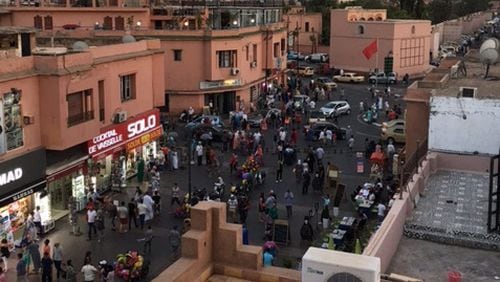The middle my family’s summer vacation landed us in the desert city of Marrakesh, Morocco. This northern African hub is unlike anything we have seen. The rustic Old City, or Medina, where locals and tourists both converge is every bit as busy as a modern city. The busyness - and craziness - of Marrakesh keeps commuters of all kinds literally on their toes and we Atlantans learned quite a lot.
Narrow, mostly-paved or stone roads sinew between short mud-rock buildings and those buildings open up as small shops and cafes on the busier streets. One gets around by landmarks and not by street names, which are not prominently displayed and change on a dime (or 10 dirhams). But the biggest challenges to commuting through Marrakesh are the unknown variables that emerge.
A walk down a tiny, crowded passage will also include expert scooter riders, bicyclists, motorists or donkey-carriage drivers powering by patiently, but unforgivably. Locals are quick to tell visiting pedestrians to stay as far to the right as possible; there are no sidewalks. Those on wheels take their time chugging through, but they expect the many pedestrians to move.
Old city Marrakesh’s rush hour is largely on foot. When the air finally tempers below 110 degrees, the plaza and streets bloom even more — and there is little contrast between regular roads and the packed bazaar. Shop fronts crowd with local women picking over discounted clothes and scarves. Homes are too hot to stay confined within, so the town’s blood is out. A quarter-mile stroll to a restaurant can take 15 minutes.
This hustle and constant awareness is exhilarating and eye-opening for foreigners, but it is by no means relaxing. Walking in this crowd means constantly looking back for scooters, ahead for oncoming people, dodging shop displays, being mindful of pickpockets and juking away from those who stop suddenly to shop. It’s harder than driving in a mall parking lot on Dec. 23. Be constantly aware.
The bigger roads surrounding the Medina area are almost as chaotic. Moroccans seem to drive with limited rules. Scooters, taxis, trucks and horse-drawn carriages share lanes (though there are supposed designated lanes for the slower ones). This controlled anarchy also means that drivers have to slow their speeds and be prepared for any kind of last-second maneuvers. It’s an environment of eat or be eaten.
But people don’t seem to take slights in traffic as personally as do we in Atlanta. The bigger roads and market streets present constant “sins,” but Moroccans are moving so quickly and effortlessly, they have no time to stew on these or flip the bird to the jerk who almost ran over their foot. Most locals I noticed were busy doing, not feeling.
Our commuting system in Atlanta is far better. But our commuting habits are not. Most of us wouldn’t go a week without a wreck in chaotic Marrakesh, if we drove or walked as distracted as we do back home. And our blood pressure would shoot to Moroccan Farenheit levels, if we took personally the maneuvers some Marrakesh drivers make.
My mentor, Captain Herb Emory, always championed using his “Three C’s” on the roads: caution, courtesy, and common sense. We needed and saw copious amounts of all three to get around safely in Marrakesh and could go to take a deep breath and employ them more in Atlanta.
About the Author






